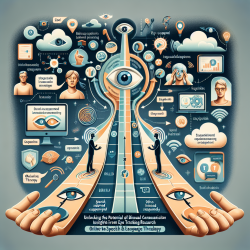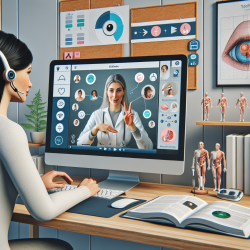In the field of speech-language pathology, data-driven decisions are essential for improving therapeutic outcomes. The study titled "An Eye Tracking Study on the Perception and Comprehension of Unimodal and Bimodal Linguistic Inputs by Deaf Adolescents" offers valuable insights into how different modes of communication affect comprehension in deaf adolescents. This blog will summarize key findings from this research and discuss how practitioners can apply these insights to enhance their therapeutic practices.
Understanding the Research
The study investigated the gaze behavior and comprehension levels of deaf adolescents when exposed to three types of linguistic inputs: spoken language, sign language, and sign-supported speech (SSS). Eye movements were tracked to determine how participants allocated their visual attention across these different modes of communication.
Key Findings
- Deaf adolescents with cochlear implants (CIs) achieved comprehension levels comparable to hearing peers across all communication modes.
- Deaf native signers without CIs achieved similar comprehension levels to hearing peers only when using their native sign language.
- Comprehension of SSS was not significantly better than spoken language, even when spatial information was communicated.
- Deaf participants primarily focused on the face, particularly the mouth area, regardless of the communication mode.
Implications for Practice
These findings suggest that while SSS does not necessarily enhance comprehension compared to spoken language alone, it does not hinder it either. For practitioners, this means that SSS can be a valuable tool, especially for deaf children with CIs who can benefit from both auditory and visual inputs. Here are some actionable steps based on the research:
- Utilize SSS in Therapy: Incorporate SSS into therapy sessions to provide a redundant stream of information, which may aid in comprehension, especially for children with early cochlear implantation.
- Focus on Face and Mouth Movements: Since deaf participants focus more on the mouth area, ensure that your facial expressions and mouth movements are clear and exaggerated to facilitate lip-reading.
- Customize Communication Strategies: Tailor your communication approach based on whether the child is a native signer or a CI user. Native signers may benefit more from sign language, while CI users might benefit equally from SSS and spoken language.
- Monitor Gaze Behavior: Use eye-tracking technology if available to monitor how children allocate their visual attention during communication. This can provide insights into how well they are comprehending the material.
Encouraging Further Research
While this study provides valuable insights, it also highlights the need for further research. Future studies should explore the effectiveness of SSS in transmitting more complex information and its impact on different age groups and educational settings. Additionally, understanding how peripheral vision and gaze behavior contribute to comprehension can offer deeper insights into optimizing communication strategies for deaf individuals.
To read the original research paper, please follow this link: An Eye Tracking Study on the Perception and Comprehension of Unimodal and Bimodal Linguistic Inputs by Deaf Adolescents.










